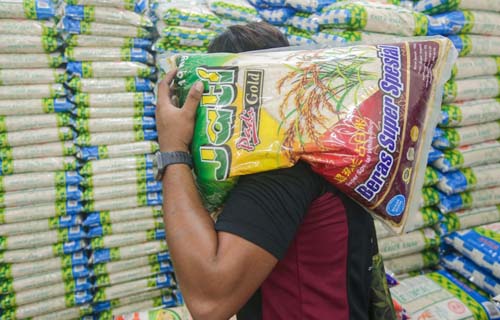What is wrong with our rice sector

Written by Prof Datin Paduka Fatimah Mohamed Arshad, she is a senior fellow at the Institute for Democracy and Economic Affairs (IDEAS)
Our rice was at centre stage again with a very peculiar problem, that is, local rice was not available in the market in the second half of last year although 64% of supply comes from local farms. Despite stern warnings from the government against manipulation of rice supply, the problem persisted for seven months, which reflects the strong dominance of rice traders in the market. No big war occurred during the period (except the continuing Russia-Ukraine conflict), there were no serious natural calamities and supply was relatively abundant in the international market, but our local rice was missing. The situation is perplexing, but there has been no shortage of explanations.
Rice crises are not new to Malaysia or the world. Malaysia went through five major crises: 1973-1975, 1980s, 1997/98, 2008 and 2023. With the exception of the 1980s, the others were due to price hikes. Price crises are driven by fundamentals (supply and demand) and technical factors (the behaviour of the market players). Nevertheless, the mix of variables and nature of technical factors in the equations shape the severity of a crisis. Of course, the lifespan of a crisis is determined by the production and trade policies taken by both importers and exporters.
All previous price crises produced similar symptoms: hoarding and rice mixing by the traders to take advantage of the price gap — local versus imported and low versus high percentage of broken rice respectively. The former is for temporal gain while the latter is arbitraging profit. The hoarding creates an artificial shortage in the local market. Time and time again these symptoms have emerged, and they are the focus of government remedial strategies including the current one, taken in 2023. In 2008, the production of the subsidised STT15% rice, which was supposedly meant for the poor, was not visible in the market. In 2023 to 2024, the problem had grown in scale where local rice was unavailable for much longer, for seven months. All the symptoms were magnified. The fact that the symptoms repeated themselves in every crisis clearly implies that firefighting remedial efforts are simply unsustainable.
The current rice crisis led the government to a number of proposals. First, to introduce one grade rice called Madani rice (a mix of imported and local rice) at RM30/10kg to legitimise the rampant rice mixing practices in the past. Implications of such a proposal are that the government control over the industry will reach 100%, replicating the paddy industry structure under a centralised economy in China and Vietnam in the 1960s. In Vietnam, the sector showed little improvement and farmers remained in perpetual poverty until it was liberalised in the 1970s, which put Vietnam on the map as the third-largest exporter of rice in the world after Thailand and India. In addition, one grade for all goes against the grain of a dynamic market where grades and standards are drivers for diversification and innovation. Besides, one price for one grade would result in subsidising the rich and indirectly “taxing” the poor.
Second, it is proposed that Nafas (National Farmers’ Organization) be appointed as an additional importer besides Padiberas Nasional Bhd (Bernas). There are two implications here. Firstly, the policy premise to create competition is commendable but short of its true meaning. Nafas and Bernas would make a duopoly, not a competitive market. The risk of market collusion in a duopolistic market is high, as in the case of Bernas-miller joint ventures. Secondly, the shortage of rice has not been quantitatively verified. If there is a real shortage, then this is the urgent issue to be addressed, that is to increase production for the next season. Besides, based on Malaysia’s past record, big government’s procurement is a fertile bed for rent-seeking practices.
Third, the government is toying with the rice price floating idea. Again, conceptually, it is a much-awaited strategy, but it has to be contextualised from the lens of the whole ecosystem. The ecosystem comprises players such as sole input distributor, farmers, middlemen, millers, Bernas (importer), wholesalers and retailers. A change in the retail price will be transmitted along the supply chain and may cause ripples here and there. There will be beneficiaries and losers. If the guaranteed minimum price (GMP) remains constant, then the farmers benefit when the retail prices are higher than the GMP and vice versa. However, price transmission from retail to farm is inefficient and non-transparent as the paddy supply chain is in the hands of powerful players with strong market power. For instance, the input distribution is handled by one agency, there are only 12 seeds suppliers and the joint venture of Bernas with millers accounts for about three-quarters of rice distribution in the country.
Past experiences show that the price transmission under a non-competitive market is highly asymmetric. That is, when the retail price is low, the millers are driven to preserve their margin by offering lower prices and higher deduction charges on paddy bought from farmers. When prices are high, the urgency is much lower. Studies have shown that high deductions on paddy reduce farmers’ receipt significantly. In addition, farmers are subjected to high cost of production and poor delivery of important input, namely seeds, water and fertiliser.
Clearly the policy narratives chosen by the government are short term in nature, treating the symptoms not the disease. All the unethical practices such as profiteering from hoarding and rice mixing, market collusion or cartel creation are rooted in the highly concentrated markets at all levels. The policies that created a non-competitive environment and highly concentrated market at all levels urgently need a revisit.
The impact of the 52-year-old protectionist regime is very telling — such as deindustrialisation, low growth, minimal small and medium enterprise (SME) development, limited innovations in supply chain, and the farming community remaining poor despite heavy subsidies. These are familiar symptoms of a highly regulated market, as proven in Bangladesh, China and selected African countries in the 1960s to 1970s before they opted for liberalisation.
The government’s resistance to reform is understandable due to fear of social disruption and in view of political interests, but change is imminent if Malaysia cares about the sustenance of this important food in the country’s food basket. Fast forward, without reformation, all the market ills such as rent-seeking behaviour of the monopolist and government officials, cartels, market collusion, unethical practices and poverty among the farmers will simply perpetually multiply. And, the public has to pay a high cost for this gross oversight.
This article first appeared in The Edge Malaysia Weekly on April 22, 2024.


